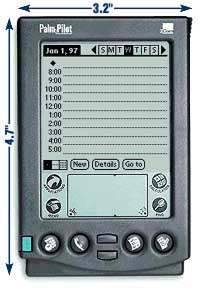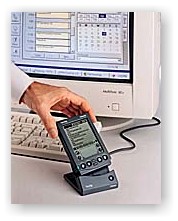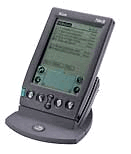
It's now updated!
 |
About the Palm
range of PDA's The 3Com Palm series of computers are excellent tiny little PDA's with a rgrayscale screen. It fits perfectly in the palm of your hand, yet is very powerful. It isn't like most other PDA's because it is very light and very small. For bad light conditions there is even a backlight like the Indigo watch light! There is no keyboard, which is good, because most PDA keyboards are slow and pretty crap, so you have to enter text using the Graffiti strokes you have to learn for it. The whole screen is a touchscreen, so no need for a mouse either. Now available is a driver for using the Newton keyboard, which is good if you really have to use a keyboard. Most people learn them within twenty minutes. The OS was developed by Palm Computing, which was bought by US Robotics, and then US Robotics merged into 3Com, or something. Battery life, unlike CE products, is measured in weeks (sometimes months), not in hours! The model on the left is an old Palmpilot Professional, one of the cheapest you can buy (especially if you find a second hand ne) |
The picture above should give you an idea of the size and display. It is so small, light and well-featured, it is amazing it was first released a couple of years ago!
There are a total of 7 buttons on the front of the PalmPilot. Four of these are assigned to the main built-in applications. Even when the PalmPilot is turned off, you just hit one of the buttons and the unit instantly turns on (no jokes, please..) and the application immediately loads. Also, if you are in the middle of a memo in MemoPad and have to turn the machine off, then the next time you use the PalmPilot it continues from where it was in the memo! The two buttons in the middle above are for page up and down, and are mainly used for scrolling documents. The blue button on the left is the Power button. If you hold down the Power button for a second or two, then the backlight is turned on.
| You can connect the Palm to your PC very easily using the supplied cradle. (right) The Pilot just sits in the cradle, and when you press the HotSync button, everything on your PalmPilot is synchronised with that on your PC. You do need a spare serial port to plug it in though, and it was pretty annoying for me because I only had one port on my PC, and it was taken up by a Serial Mouse! I fixed that quickly, though. There are hundreds of apps on the Internet for the Palm, and they can all be downloaded very quickly as they are not very large files, usually up to 40k at most! These can be downloaded onto your PC/Unix, and then installed at Hotsync, or you can install directly using Proxiweb. Proxiweb will "look" into zip files and let you select what files to download. For this reason, There are huge zip libraries on this website. Try them out! A huge selection of mostly free software. |  |
There are now five types of Pilot; the Pilot 1000, Pilot 5000, PalmPilot Personal, PalmPilot Professional, the PIII, PIIIx, and the Palm VII. More are set to arrive in the near future.
The most basic is the 1000 which has only 128kb of memory and no backlight. The 5000 has 512kb of memory and no backlight. The PalmPilot Personal has 512kb of memory and a backlight, and the Professional is the same as the Personal, except it has 1mb of memory, a TCP/IP stack and an email program. The PalmPilot Personal and Professional are more rugged and have been strengthened. The screen has been made more tough also. For more information on thee different Pilots, go to 3Com's site or the official Palm website instead. If you are strapped for cash, the best model to get is the 128k Pilot 1000, as this can be upgraded later with the 1mb or 2mb upgrade. They are pretty old, and can only be bought second-hand from Newsgroups.This upgrade gives the same effect as upgrading from a Pilot 5000 or Palmpilot Personal. The backlight, however, is not included in the upgrade, and the casing is not as rugged, and there are some design flaws. So, if you have the cash, get the PalmPilot Professional if you really need the Email options. With the arrival of the P3, though, the only advantage of buying a Professional is that it is cheaper. It is well worth getting the P3 as it has a few neat features:-
 |
There is now 2mb of
memory, updated built-in appplications, all the features
of the Palmpilot Professional, an IR port at the top of
the P3 for sending information and applications to other
Palmpilots with the IR port, a new ergonomic design, and
newer versions of Hotsync with Hotsync folders and
updated Desktop and Cradle. The stylus has been
remodelled, and now fits much better in the hand, and has
a little paperclip at the back for Reseting the machine. I also hear that the IR port can be used as a controller for IR TVs, HIFIs, VCRs and other IR devices, but special software has to be written to do this! Anyone willing to try it out? |
There is a very attractive offer going out to owners of old Palmpilots. They can be upgraded to 2mb with TCPIP and the IR port plus PalmOS3 for only $129 or thereabouts, instead of having to buy a new P3. This is good news, as the upgrade before that would only update to a Palmpilot Professional.
Other new devices are manufactured by other companies, but license Palm OS from 3Com. The latest new machines from 3Com are the PalmIIIx (Palm OS 3.3) and the PalmVII. The Palm VII has a built in wireless modem, but as far as I know is only really designed for major companies, and I'm not sure if it will work in Europe. I have never actually got hold of one, unfortunetly. The newer the machine, the slimmer it gets, and there haven't been many OS upgrades, which means that most older software still works and is useful, and also that those of us with older machines aren't left behind!
The Palm is now capable of handling email and the Internet. Software such as Proxiweb and Proximail (www.proxinet.com) allow you to retrieve your email and access the Internet without having to return to your desktop computer! You simply connect your Palm to a Modem using the modem cable and the software will dial your ISP; totally independant of your Desktop! This is great because the Email app that comes with all Palmpilot Professionals and the P3 is only for syncing with Outlook or some other email program on your desktop. As far as Surfing the Net goes on Palms, it does a very good job, with various text-only browsers available, and a graphical browser, Proxiweb. All are free and should be downloaded immediately. Unfortunately, these browsers and email apps can only be used with a Palm that has the TCPIP stack.(Palmpilot Professional or later)
Finding a modem to work with the Palm is very easy, as most external bog-standard models work (using the modem cable: $20!), or you can use the specially-built Palm Modem ($100 from www.palm.com or www.palmgear.com) which clips onto the Palm like the cradle, and runs on two AAA batteries which I'm told last very long. There is information on the Palm website that lists the modems that are compatible with the modem cable. This should be checked before buying a modem specifically for your Palm. Or make your own!
Another useful aspect of the Palm is to use it as an etext viewer. The problem with the memopad program is that it does not allow for large-sized files. This is where the Doc format comes in handy, as the only limit is the amount of memory on the Palm. There are a couple of apps for the Palm that allow you to view these doc files, which are available from all over the net. Tealdoc and Aportisdoc are probably the most popular, but do not allow you to edit. Software such as Qed will allow you to create and edit Docs right on the Palm. Don't forget that creating your own docs is also very easy using the array of apps for the PC, Unix machines and Macs. Qex is very good at this. Check them out! Smartdoc and CSpotRun are also recommended, so run off to www.palmcentral.com for a look. Most viewers and Editors are shareware or Trialware. There are hundreds of books available online, and are already formated to suit the display of the Palm. Follow the links below to find viewers and the etexts themselves. Of course, you can get one of the most popular ones on this website, Undocumented Palm Info 2.0. Thousands of people acknowledge that there is loads of invaluable information in it. So go get it!
See above for information on QED, QEX and the doc format
There is also another very handy utility on the net called Image Viewer. Basically, Image Viewer allows you to convert Windows graphics files to a format that the Image Viewer on the Palm can read. The Windows Image Converter is free, and the Palm Image Viewer is shareware. There is, however, a freeware viewer that can display ImageViewer files called Tiny Viewer. This can be found in the Lib1.zip file.Both of these programs work very well. Other utilities, both Desktop and Pilot based, are available to compress and organize these images. There are also desktop apps that allow you to preview ImageViewer files on the PC. The most obvious thing to do with the Image Viewer is to store maps on it. The maps available at MapQuest translate very well onto the Palm, and seeing as the maps are free, it'e well worth having a couple on your Palm! See the link below for Mapquest.
There is more software for you on the Software page, over 2mb in fact. What are you waiting for?!
Email: davidb@eircom.net